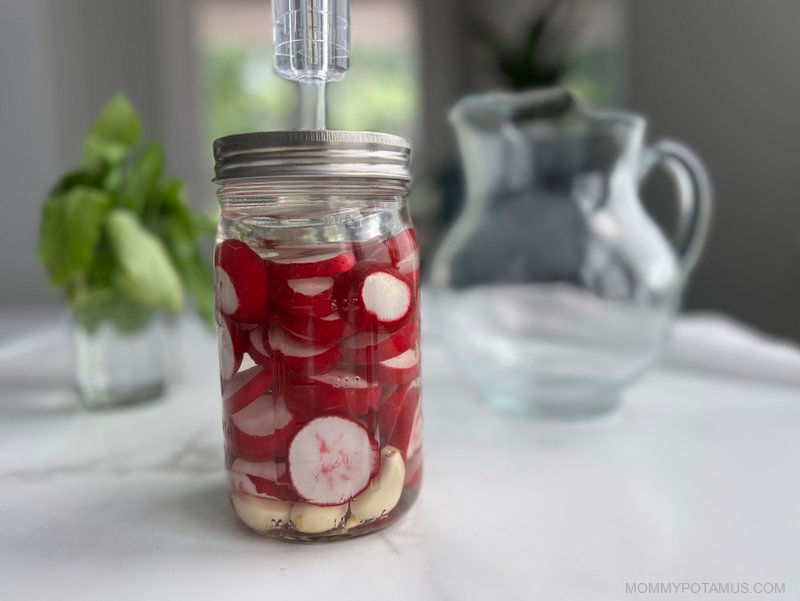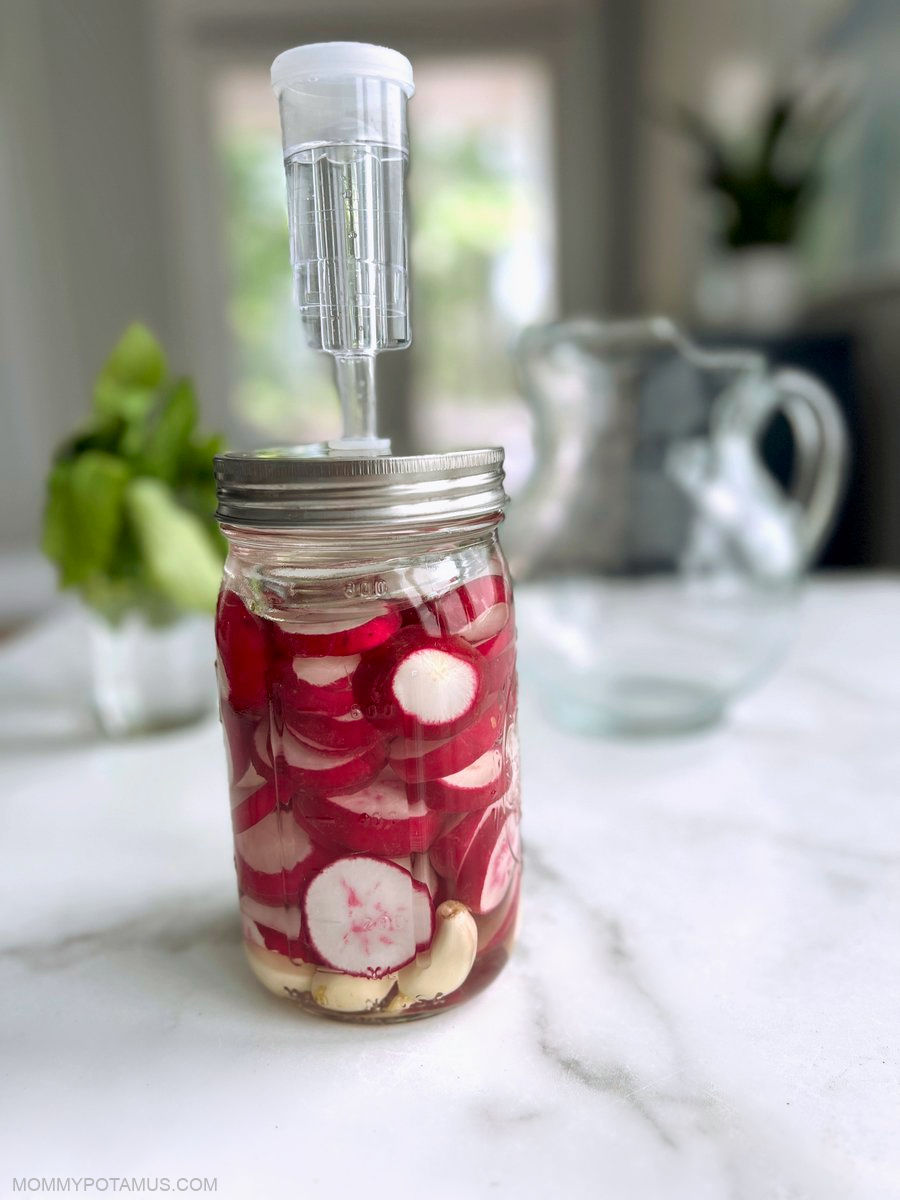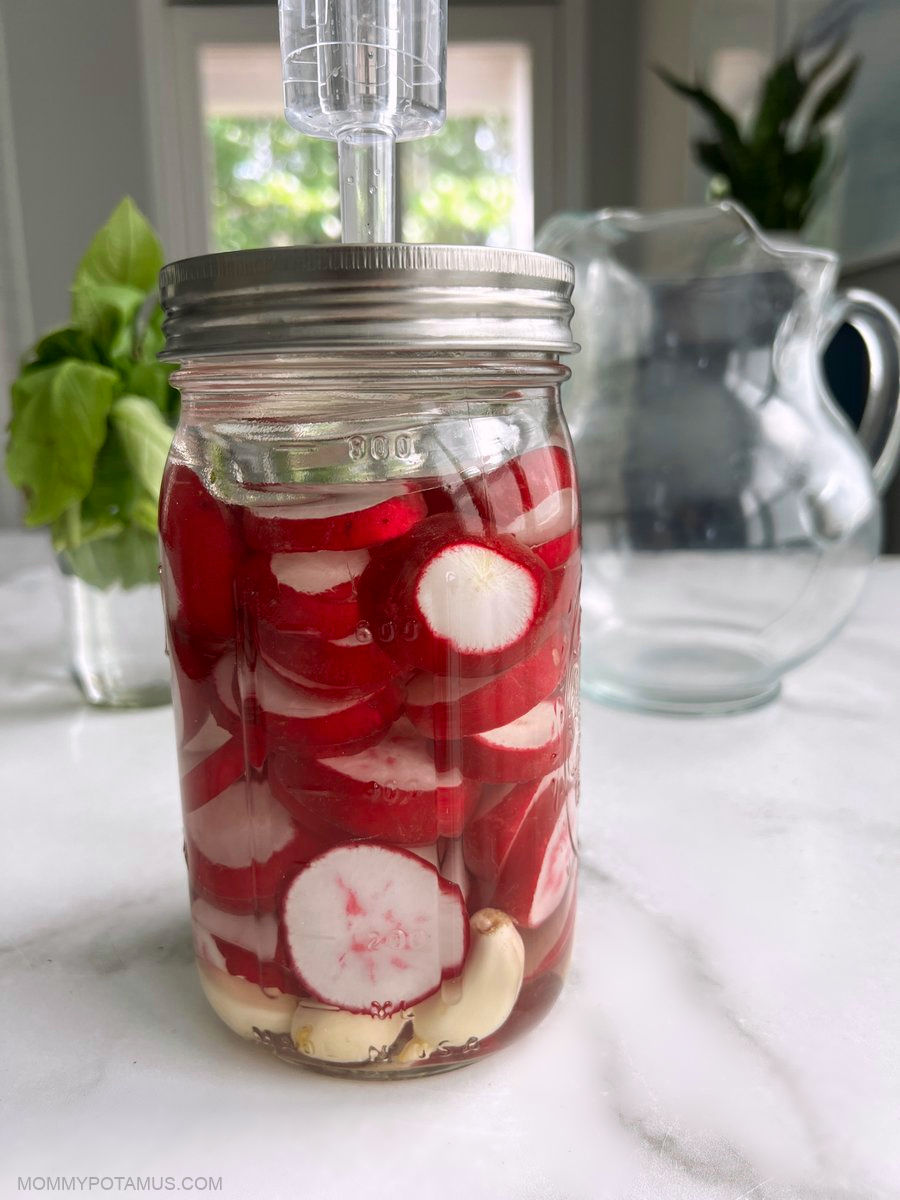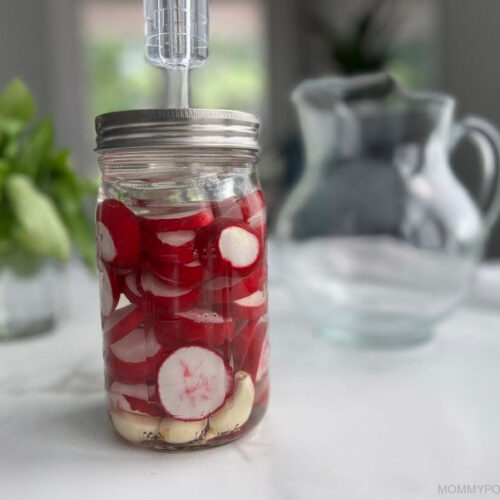
If you don’t love radishes, this recipe just might change your mind! Fermenting radishes takes some of the “bite” out of their flavor, replacing it with a crunchy, salty, slightly sour tang. My kids call them “radish pickles” and have been known to ask for second and third helpings . . . seriously!
They make a great addition to salads and charcuterie boards, and they can also be used as “chips” for things like hummus or ranch dressing.
Also, thanks to a process called lacto-fermentation, they’re rich in gut-friendly probiotics. Here’s how it works:
- Put veggies in a clean vessel.
- Add a saltwater brine to the vessel and seal it.
- Let the magic unfold.
By magic, I mean that lactobacillus bacteria – which are naturally present in veggies – are tolerant to saltwater, while most bad guys can’t take much of it. When we place veggies in a saltwater brine it gives the good guys the advantage, allowing them convert sugar and starches into lactic acid.
Other Benefits
Lactic acid is also helpful for:
- Improving the flavor profile (adding tartness/sourness)
- Extending the shelf life (lactic acid fermentation was one of the primary methods used to preserve foods for generations)
- Breaking down digestion inhibitors (oxalates and phytates) so that nutrients are more bioavailable. (1)
As a byproduct of fermentation, lactobacillus bacteria can also produce additional nutrients like vitamin K2, which are not naturally present in veggies. (2) So, in a nutshell, you get flavor, probiotics, improved digestibility, and additional vitamins.
What You’ll Need
To get started, you’ll need to gather your ingredients and some basic equipment like a wide-mouth quart jar and:
- An airlock lid that fits a standard wide-mouth mason jar OR a regular lid if you’re willing to “burp” the jar periodically (details in notes section)
- A glass weight to hold the radishes under the brine
Also, if your bunch came with the radish greens attached, don’t toss them – try this pesto recipe. Now let’s get to the recipe!

Lacto-Fermented Radishes
Equipment
- quart-size mason jar
- Fermentation weight*
- fermentation lid with airlock (optional)
Ingredients
- 3 cups sliced fresh radishes
- 2-3 whole garlic cloves (peeled)
- 3.5 tsp sea salt (non-iodized)
- 4 cups filtered water
Instructions
- Thoroughly clean your mason jar, lid, and cutting before getting started.
- Boil the water for five minutes, then measure out 3.5 cups of water and stir in the salt until it dissolves. Allow the brine to cool to room temperature.
- Place the peeled garlic cloves in the mason jar.
- Slice the radishes thinly and pack them into the fermenting jar, leaving about 1.5 inches of headspace between the top of the radishes and the lid.
- Pour the room temperature salt brine over the radishes until they are completely covered, leaving at least one inch of headspace between the top of the brine and the lid.
- Place a weight inside the mouth of the jar to keep your radishes under the brine. Place the lid on the jar and set up the airlock if you’re using one.
- Allow the jar to ferment at room temperature for 3-5 days, depending on how tangy you want them to be. Keep it out of direct sunlight – I keep mine in a shady area of my kitchen or one of my kitchen cabinets. Taste your fermented radishes starting on day 3, and when it reaches a flavor that you like transfer it to the fridge. If you're using a lid with an airlock, replace it with a regular mason jar lid before storing it.
Notes
Nutrition
More Fermented Vegetables To Try
Kimchi – Spicy and delicious, this simple kimchi recipe is a family favorite.
Fermented Carrot Sticks With Dill – Tangy and crunchy, these easy fermented carrots make a delicious snack or side dish for meals. Enjoy them plain or dipped in creamy homemade ranch dressing or onion dip.
Beet Kvass – This recipe is infused with ginger, which adds a pleasant flavor and also supports digestion.
Fermented Jalapenos – These “pickled” jalapeños are a total crowd-pleaser. Serve them on nachos, pizza, Mexican dips, salads, and more for a delicious pop of flavor.
Sources
- Nikhata, Smith G. et. al. (2018) Fermentation and germination improve nutritional value of cereals and legumes through activation of endogenous enzymes
- Liu, Yue (2019) Long-chain vitamin K2 production in Lactococcus lactis is influenced by temperature, carbon source, aeration and mode of energy metabolism

Continue reading Garlicky Fermented Radishes Recipe (Pickled Radishes)...

